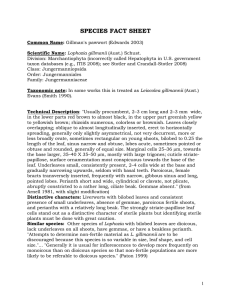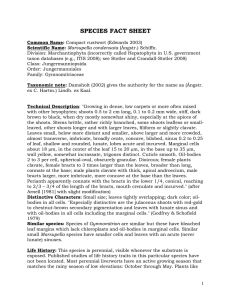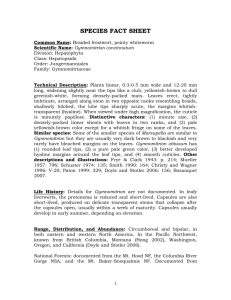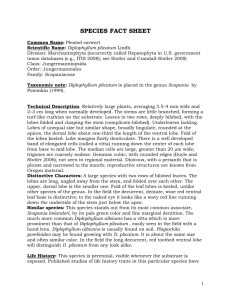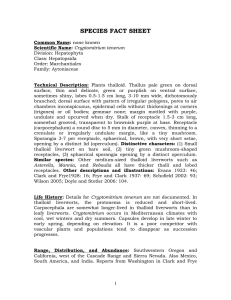Cephaloziella spinigera
advertisement
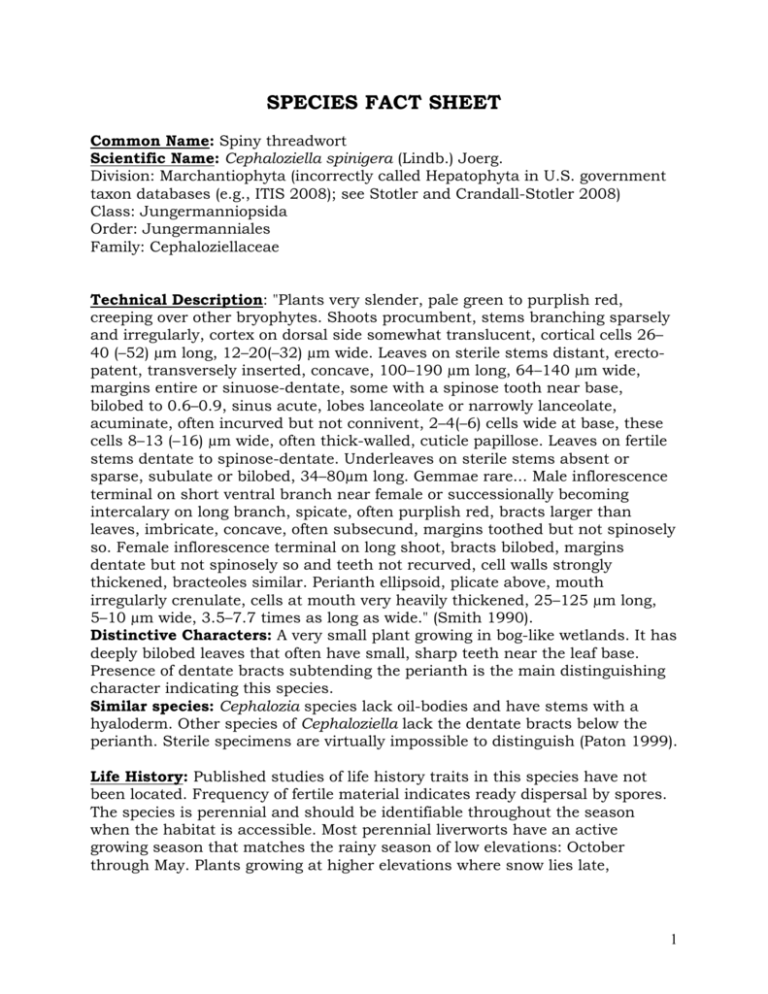
SPECIES FACT SHEET Common Name: Spiny threadwort Scientific Name: Cephaloziella spinigera (Lindb.) Joerg. Division: Marchantiophyta (incorrectly called Hepatophyta in U.S. government taxon databases (e.g., ITIS 2008); see Stotler and Crandall-Stotler 2008) Class: Jungermanniopsida Order: Jungermanniales Family: Cephaloziellaceae Technical Description: "Plants very slender, pale green to purplish red, creeping over other bryophytes. Shoots procumbent, stems branching sparsely and irregularly, cortex on dorsal side somewhat translucent, cortical cells 26– 40 (–52) µm long, 12–20(–32) µm wide. Leaves on sterile stems distant, erectopatent, transversely inserted, concave, 100–190 µm long, 64–140 µm wide, margins entire or sinuose-dentate, some with a spinose tooth near base, bilobed to 0.6–0.9, sinus acute, lobes lanceolate or narrowly lanceolate, acuminate, often incurved but not connivent, 2–4(–6) cells wide at base, these cells 8–13 (–16) µm wide, often thick-walled, cuticle papillose. Leaves on fertile stems dentate to spinose-dentate. Underleaves on sterile stems absent or sparse, subulate or bilobed, 34–80µm long. Gemmae rare... Male inflorescence terminal on short ventral branch near female or successionally becoming intercalary on long branch, spicate, often purplish red, bracts larger than leaves, imbricate, concave, often subsecund, margins toothed but not spinosely so. Female inflorescence terminal on long shoot, bracts bilobed, margins dentate but not spinosely so and teeth not recurved, cell walls strongly thickened, bracteoles similar. Perianth ellipsoid, plicate above, mouth irregularly crenulate, cells at mouth very heavily thickened, 25–125 µm long, 5–10 µm wide, 3.5–7.7 times as long as wide." (Smith 1990). Distinctive Characters: A very small plant growing in bog-like wetlands. It has deeply bilobed leaves that often have small, sharp teeth near the leaf base. Presence of dentate bracts subtending the perianth is the main distinguishing character indicating this species. Similar species: Cephalozia species lack oil-bodies and have stems with a hyaloderm. Other species of Cephaloziella lack the dentate bracts below the perianth. Sterile specimens are virtually impossible to distinguish (Paton 1999). Life History: Published studies of life history traits in this species have not been located. Frequency of fertile material indicates ready dispersal by spores. The species is perennial and should be identifiable throughout the season when the habitat is accessible. Most perennial liverworts have an active growing season that matches the rainy season of low elevations: October through May. Plants growing at higher elevations where snow lies late, 1 generally above 1500 m (5000 ft), may have a short growing season that coincides with late summer and fall. Range, Distribution, and Abundance: Widespread around the northern hemisphere in boreal and montane regions. In western North America reaching the southern edge of its range in northern California (Doyle and Stotler 2006). More common northwards, although reports from Washington are lacking. Rare in Oregon, where found in Woahink Bog in Lane County and Bull Swamp, Klamath County. Oregon Natural Heritage Information Center lists this in Klamath and Lane Counties, Oregon. BLM: Suspected in Coos Bay, Salem, Eugene, and Roseburg Districts, and Klamath Falls Resource Area. USFS: Documented in Fremont-Winema National Forest. Suspected in Columbia River Gorge National Scenic Area, Deschutes, Mt. Hood, Rogue River-Siskiyou, Siuslaw, Umpqua and Willamette National Forests. Habitat Associations: A bog and fen species, in Oregon associated with such genera as Warnstorfia, Drepanocladus, Tomenthypnum, and Meesia. Threats: Habitat disturbance which changes wetland hydrology would negatively affect this species. Conservation Considerations: Consider protecting bogs and fens where this species occurs by a large enough management buffer to preclude wetland hydrology and water quality changes. Conservation Rankings and Status: Global: G3G4; Oregon: S2 ORNHIC List 3 Washington: Not ranked BLM/USFS Strategic species in Oregon Other pertinent information: Surveys and Survey Protocol: Focus on wetlands dominated by bryophytes, which may be classified as fens or bogs. Key to Identification of the Species: Doyle and Stotler 2006; Christy and Wagner 1996. 2 Preparer: David H. Wagner Edited by: Rob Huff Date Completed: October, 2008 Updated in May 2009 by Candace Fallon (Update added Attachment 1, Photos, to the Species Fact Sheet). ATTACHMENTS: (1) Photos References: Christy, J.A. & D.H. Wagner. 1996. Guide for the identification of rare, threatened or sensitive bryophytes in the range of the northern spotted owl, western Washington, western Oregon and northwestern California. USDI Bureau of Land Management, Oregon-Washington State Office, Portland. 222 pp. Doyle, W. T. & R.E. Stotler. 2006. Contributions toward a bryoflora of California III. Keys and annotated species catalogue for liverworts and hornworts. Madroño 53: 89-197. Oregon Natural Heritage Information Center. 2007. Rare, threatened and endangered species of Oregon. Oregon Natural Heritage Information Center, Oregon State University. Portland. 100 pp. http://oregonstate.edu/ornhic/2007_t&e_book.pdf Paton, J.A. 1999. The liverwort flora of the British Isles. Harley Books, Colchester, U.K. 626 pp. Smith, A.J.E. 1990. The Liverworts of Britain and Ireland. Cambridge University Press, Cambridge, England. Stotler, R.E. and B. Crandall-Stotler. 2008. Correct author citations for some upper rank names of liverworts (Marchantiophyta). Taxon 57: 289-292. 3 Attachment 1 – Photos All photos by Dr. David Wagner, under contract with the Oregon/Washington Bureau of Land Management. Autoicous shoot 4x Gynoecium 4 Gynoecium Shoots 5 Leaf with oilbodies 6

